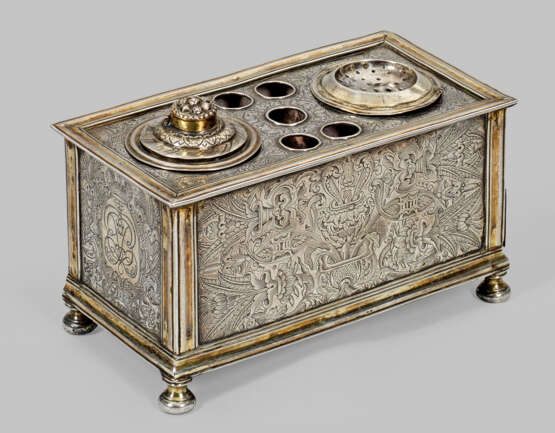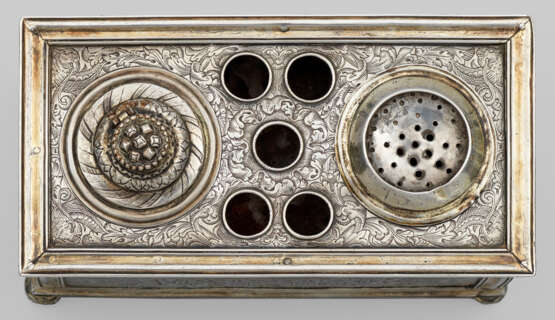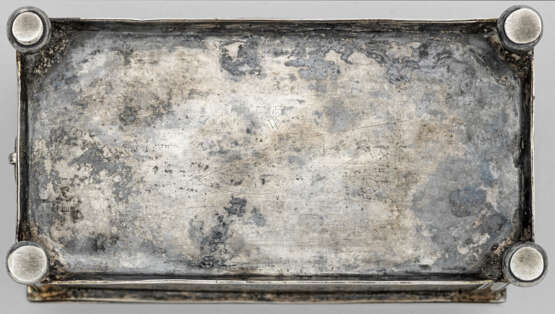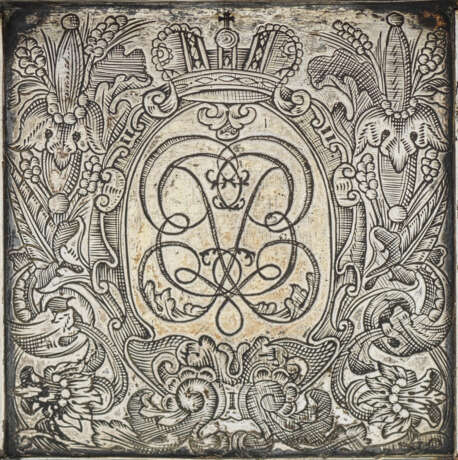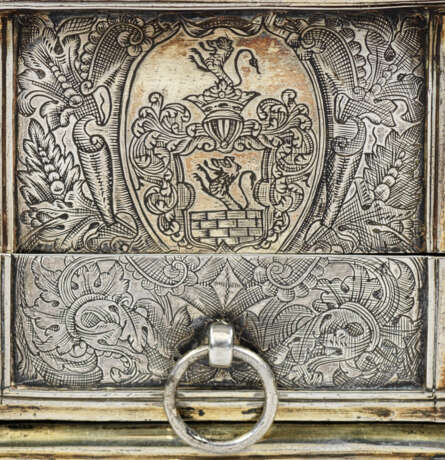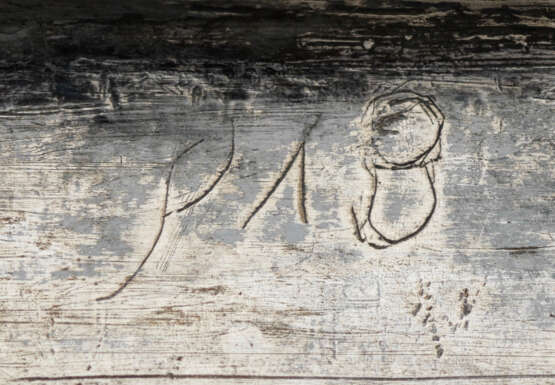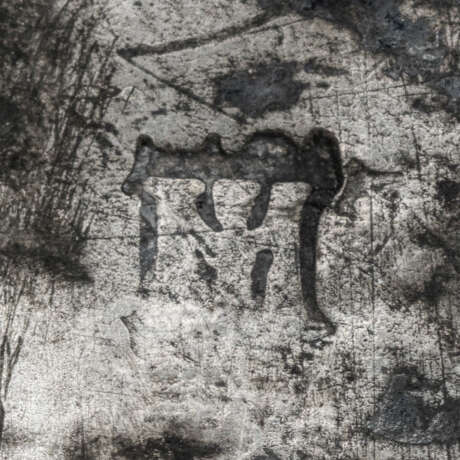ID 1081672
Lot 251 | Historisch hochbedeutendes Renaissance-Schreibkästchen
Estimate value
€ 36 000 – 72 000
Historisch hochbedeutendes Renaissance-Schreibkästchen mit Monogramm von Zar und Kaiser Peter I. von Russland (1672 - 1725)
Silber, teilw. mit Restvergoldung. Rechteckiger Korpus auf vier Nodusfüßen. Ränder und Seitenkanten mit mehrfach profilierten Zierleisten umzogen. Seitlich durchgängiges Schubfach mit Ringöse. Oberseite mit zwei großen runden Einlässen für Tintenfass und Sandstreuer sowie fünf kleinere als Federhalterungen. Allseitig flächendeckender, feiner Gravurdekor aus üppigem Blatt- und Rankenwerk, Früchten, Blumen, Ohrmuschel- und Schweifornamentik sowie obenauf mit stilisierten Adlerköpfen. Am Boden das gravierte Monogramm "FWC" für Friedrich Wilhelm Kurfürst von Brandenburg (1620 - 1688). Schublade mit alter Gewichtsangabe "No: 4 3M : 5L: 1qt:". Auf einer Schmalseite das ligierte Spiegelmonogramm "P E" (Peter Empereur) unter russischer Kaiserkrone von Peter I. von Russland (die Identifizierung des Monogramms bestätigte Frau Dr. Lopato, Kuratorin für Silberarbeiten der Eremitage in St. Petersburg). Eine ähnliche Monogramm-Chiffre befindet sich auf der Zeichnung eines Triumphbogens, der anlässlich des Friedens von Nystad mit Schweden 1721 von Peter I. in Auftrag gegeben wurde. Auf gegenüberliegender Seite das gravierte Wappen der preußischen Adelsfamilie von Langen - Wilhelm von Langen (1706 - 1758) war ab 1737 Offizier im russischen Militärdienst. Wahrscheinlich bekam er das Kästchen für militärische Verdienste vom Kaiserhof als Geschenk. Ein weiteres auf der Bodenunterseite graviertes Inventarmonogram "PAB" steht wohl für "Peter Alexejewitsch Beliki" (Peter der Große). Gest., Beschauzeichen, Ältermann Moritz Kop (ab 1577), Meister Jacob Mores d. Ä. (wird Meister um 1579). Gew. ca. 780 g. H. 9,5 cm. 16 cm x 8,3 cm.
Jacob Mores I fertigte hochwertigste Objekte aus Silber im Auftrag europäischer Königs- und Fürstenhäuser. So befand sich auch dieses Kästchen im Besitz der brandenburgischen Kurfürsten und Könige in Preußen. König Friedrich Wilhelm I. (1688 - 1740) und der Zar pflegten enge freundschaftliche Beziehungen sowie einen regen diplomatischen Geschenkaustausch. Er dürfte das Kästchen anlässlich der Krönung des Zaren zum Kaiser des Russischen Reiches 1721 überreicht haben. Das wohl bekannteste Geschenk Friedrich Wilhelms I. ist das berühmte Bernsteinkabinett. Ein vergleichbares Schreibkästchen aus Kupfer befindet sich im St. Petersburger Sommerpalast.
Vgl. Schliemann, 1985, Bd. II, S. 7, Nr. 19, S.46, Nr. 105, S. 52, Nr. 115; Neuer Siebmacher, Bd. V, Tafel 31/S. 51; N. I. Pawlenko, Peter der Große, Moskau 1998, S. 64, S. 106, Abb. 386; Monogramme auf Münzen und Urkunden, Fläming, S. 22, Nr. 686.
A highly significant German Renaissance silver writing casket by Jacob Mores I (master since 1579) probably as a later gift from Elector Friedrich Wilhelm I to Tsar and Emperor Peter I of Russia (the Great). With residual gilding. Engraved monograms, old weights and the coat of arms of the noble von Langen family. Assay and master´s mark.
Deutsch. Hamburg. Um 1580.
| Address of auction |
Kunstauktionshaus Schloss Ahlden GmbH Große Str. 1 29691 Ahlden(Aller) Germany | ||||||||||||||
|---|---|---|---|---|---|---|---|---|---|---|---|---|---|---|---|
| Preview |
| ||||||||||||||
| Phone | +49 5164 80100 | ||||||||||||||
| Buyer Premium | 25.0 | ||||||||||||||
| Conditions of purchase | Conditions of purchase | ||||||||||||||
| Business hours | Business hours
|
